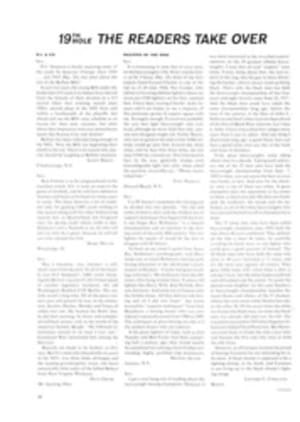
THE MAN WHO LOVED CAT KILLING
In an era when hunting is under the gun, the last thing the sport needs is the sort of outdoors immorality revealed last month in Boise, Idaho. It was the final chapter of a tale of illegal, cold-blooded slaughter that would have made an Esau blush. The victims were a black leopard and four spotted jaguars, all of them caged and illegally smuggled into New Mexico, then released before the guns of hunters who had been told they wer shooting "wild varmints."
Before Judge J. Blaine Anderson in the U.S. District Court in Boise, the perpetrator of the misdeeds, Curtis Jackson Prock, 60, of McCall, Idaho and Belize City, Belize, pleaded nolo contendere to conspiracy, one of six counts contained in an indictment issued by a New Mexico federal grand jury. The other five counts were dismissed on a motion by Assistant U.S. Attorney Wilbur Nelson.
Prock, one of the West's most renowned hunting guides, was an organizer of "guaranteed" hunts in which the price of a jaguar ran to $3,500. Until recently Prock conducted what are assumed to be wholly legal jaguar hunting operations on his ranch in Belize. There he guided such well-known outdoorsmen as Joe Foss, former governor of North Dakota and commissioner of the old American Football League, and John Connally, former governor of Texas, on cat hunts that inevitably produced. Then, on March 30, 1972, the jaguar was declared an "endangered species" whose hunting was forbidden worldwide except under the most stringent of licensing procedures. That closed down Prock's Belize operation—at least temporarily.
Soon afterward, wealthy hunters who contacted Prock began hearing strange and exciting yarns of wild jaguars on the loose in southern New Mexico. According to Dr. James S. Findley, curator of mammals at the University of New Mexico's Museum of Southwestern Biology, there have been only three authenticated sightings of jaguars in the state in this century—and the most recent of these took place before 1910. But Prock was right. There were jaguars in New Mexico simply because Prock was releasing them from cages virtually under the rifle sights of his enthusiastic hunters.
The locale where the cats were said to be pocketed was the high country around Apache Creek, about a day's drive southwest of Albuquerque. In early August 1972 Prock began bringing clients into the Apache Creek country, and jaguars began to die. On the 10th and 11th of that month, according to the indictment, one Rodolfo F. Barrera, a wealthy businessman of Monterrey, Mexico, paid Prock for the privilege of zapping two cats there. Over the next seven months seven more jags were taken, as well as three cougars and two bobcats. Enforcement officers of both the New Mexico Department of Game and Fish and the U.S. Fish and Wildlife Service uncovered evidence that some, if not all, of the cats were trapped and illegally imported.
Prock's clients have told investigators a chilling story of how all this occurred. The cats that finally appeared as targets for Prock's hunter were probably either trapped somewhere in Latin America and then smuggled across the Mexican border (in the case of the jag), or brought in across state lines (as with some of the cougars and certainly the leopard). In one case an agent in Spokane discovered that on Oct. 30, 1972 Denver Hammons (who was named one of Prock's co-conspirators) appeared at the Southwick Animal Farm in Blackstone, Mass. and picked up a jaguar, a grizzly bear, an arctic wolf and a black leopard, along with two cougars. He paid for the animals with a $3,900 check signed by C.J. Prock.
To anyone who has ever hunted wild game, the ease with which Prock's "guaranteed hunts" went off should have been as suspiciously smelly as a week-old wolf carcass. Take the experience of Dr. Arthur Bator of East Lansing, Mich. Bator is an optometrist and an inveterate sheep hunter. He has had enough experience to know how challenging a big-game hunt can be. Yet on the morning of Feb. 17, 1973, within a few minutes of his arrival at the Apache Creek country, he had a jaguar in the sights of his rifle, and an instant later it was dead. "A bell should have rung right then," Bator said later, "but sometimes it will happen for you that way—only rarely, to be sure—but it can happen. Then, only about an hour later, by darn if we didn't have a bobcat bayed. I shot it. That afternoon we got a mountain lion. Three trophy cats in one day's hunting. When the agents began checking with me on the details of the hunt, and I became aware that it had probably been 'canned,' I was as sick at my soul as a hunter could ever be."
Bator has a photograph of himself and Prock posed beside the carcass of the jaguar. The two men have assumed the traditional mien of the successful hunter, though Dr. Bator looks a bit worried. Perhaps it is because his freshly slain tropical cat is lying in about four inches of fresh-fallen snow.
Another client of Prock's was Bill Bee-be, an outdoors writer from Santa Monica, Calif. Beebe hunted black bears with Prock last April in Idaho, near the guide's ranch. His partner on the hunt was Bill Poole, a big-game enthusiast who makes his living as the owner and highly efficient skipper of a long-range party boat.
The first day Beebe and Poole sat in Prock's truck while his dog pack howled vainly after a bear it could not tree. "Prock told us not to worry, there were plenty more bears around," Beebe recalled. "At four the next morning C.J.'s wife Dorothy came pounding at the door of our motel room. 'Come on,' she yelled, 'C.J.'s got a bear treed.' " According to Beebe, he was a little suspicious when Mrs. Prock told him that C.J. had the bear cornered about four or five miles down a dirt road on the outskirts of town and to look for his truck on the left-hand side of the road.
They found Prock, all right, and a bear cornered in a stand of lodgepole pine. Bill Poole killed it. An hour later the dogs bayed another bear, and it was up to Beebe to shoot it. "I did," Beebe recalls, "but I'm not a damned bit proud that I did. When it tumbled out of the tree I saw that its hide was badly rubbed. In April a bear should be fresh out of hibernation, with a hide as thick and glossy as an Afghan rug. I wondered then about the scrapes—that they might have been the result of caging. And just as I never had the guts to say no and let that bear go, I never had the guts to ask Prock if the bear had been a released animal."
One hunter who did have the guts to say no to a Prock setup was Roy L. Goulart, a real-estate magnate from El Cajon, Calif. On the morning of Feb. 19, 1973 Goulart was offered a shot at a jaguar cornered by Prock's dogs in the Apache Creek area. Goulart refused the shot: the cat was too small for his taste. Prock was dismayed, but that night he brought another cat—this time a good-sized one—into Goulart's sights. Goulart took it. Like so many of the men who hunted with Prock, Goulart had been told that the matter of licenses and permits had already been taken care of out of their down payment. After all, with a $3,500 price tag on a jaguar, one assumes that the nitty-gritty details of the hunt have been looked after by the guide. In point of fact, Goulart had no license, and thus his name appeared in the indictment, though not as one of those indicted.
Most of the detective work in the case was performed by Nando Mauldin, 46, formerly assistant chief of wildlife enforcement for the New Mexico Game and Fish Department and now an administrative staff officer with the U.S. Fish and Wildlife Service. During his nearly 19 years with the department Mauldin was the busiest buster of game-law violators in New Mexico's history. But the Prock case was probably the biggest—and surely the most scandalous—of his career. It came to his attention after a federal wildlife agent in Spokane, Dale Home, discovered some jaguar hides sent from New Mexico in the inventory of the Knopp Bros. Taxidermy Studio. Home knew there were no wild jaguars in New Mexico and the investigation came into Mauldin's hands.
Under the Lacey Act, which prohibits interstate transportation of unlawfully taken wild animals, Prock was liable to a $10,000 fine and /or a year in prison for each of his alleged violations. On the conspiracy charge the penalties are the same. Moreover, courts usually look sternly at second offenders: Prock had been convicted of a Lacey Act violation in Arizona on June 19, 1964 when a U.S. District Court judge fined him $300 and suspended a 90-day prison sentence, at the same time forbidding Prock any further guiding in Arizona.
Despite Prock's past performance, Judge Anderson was remarkably lenient. He fined Prock $5,000 and sentenced him to a year in prison, plus two years probation, on the conspiracy charge—then suspended all of that sentence except for a $2,000 fine.
"You bet your life I'm mad," exclaimed Rick Smith, the young Albuquerque-based Assistant U.S. Attorney who had prepared the original indictment and who had rather naively gone along with the plea-bargaining settlement by which Prock avoided trial on the five charges involving the cats themselves. "The $2,000 fine works out to less than the sales taxes Prock would have paid for that amount of hunting. If I'd said no to the plea, and even if we had lost on all six counts, still we would have punished him financially—just in the legal costs—far more than this fine does. I feel terrible about it."
What makes not only Smith but everyone else involved in the investigation feel even worse is the fact that the New Mexico Department of Game and Fish spent between $10,000 and $20,000 on the case, not including Investigator Nando Mauldin's time. Citing the "extremely flagrant nature" of the crimes, the department's director, Ladd S. Gordon, said, "We recognize that the courts are under certain constraints, but we in the wildlife profession feel that the most effective way to minimize these serious types of violations lies in considerably greater penalties being assessed." Gordon left unstated the fear that every outdoorsman who respects game and the game laws must feel: If a man like C.J. Prock can get away with that kind of game law violation with a mere slap on the wrist, what incentive is there for investigative agencies and men like Mauldin and Home to continue their work? And what real hope is there left for endangered species like the jaguar?
ILLUSTRATION
ALAN MARDEN

